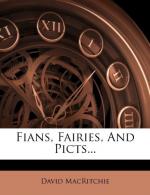Fians, then, are associated or identified with Fairies, and also with Picts. To complete my equilateral triangle, the Picts ought also to be regarded as Fairies, or as akin to them.
This undoubtedly is a popular belief. The earliest alleged reference of this kind is placed by one writer in the middle of the fifteenth century, before the Orkney Islands had passed from the crown of Denmark to the crown of Scotland. A manuscript of the then Bishop of Orkney, dated Kirkwall 1443, states that when Harald Haarfagr conquered the Orkneys in the ninth century, the inhabitants were the two “nations” of the Papae and the Peti, both of whom were exterminated. By the former name is understood the Irish missionaries: the Peti were certainly the Picts, or Pehts.[50] Now, of these Picts of Orkney it is said, that they “were only a little exceeding pigmies in stature, and worked wonderfully in the construction of their cities, evening and morning, but in mid-day, being quite destitute of strength, they hid themselves through fear in little houses under ground."[51]
The exact date of this statement is at present doubtful, but it is quite in accordance with the widespread ideas held throughout Scotland and Northumberland with regard to the Picts: that they were great as builders, but were of very low stature, and closely akin to Fairies.[52] Moreover, they are famous for doing their work during the night. Whatever be the explanation of the above curious statement that at mid-day they lost their strength and withdrew to their underground houses, it is at any rate interesting to compare with it the remark made by the traveller Pennant as he was passing along Glenorchy in 1772.




